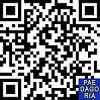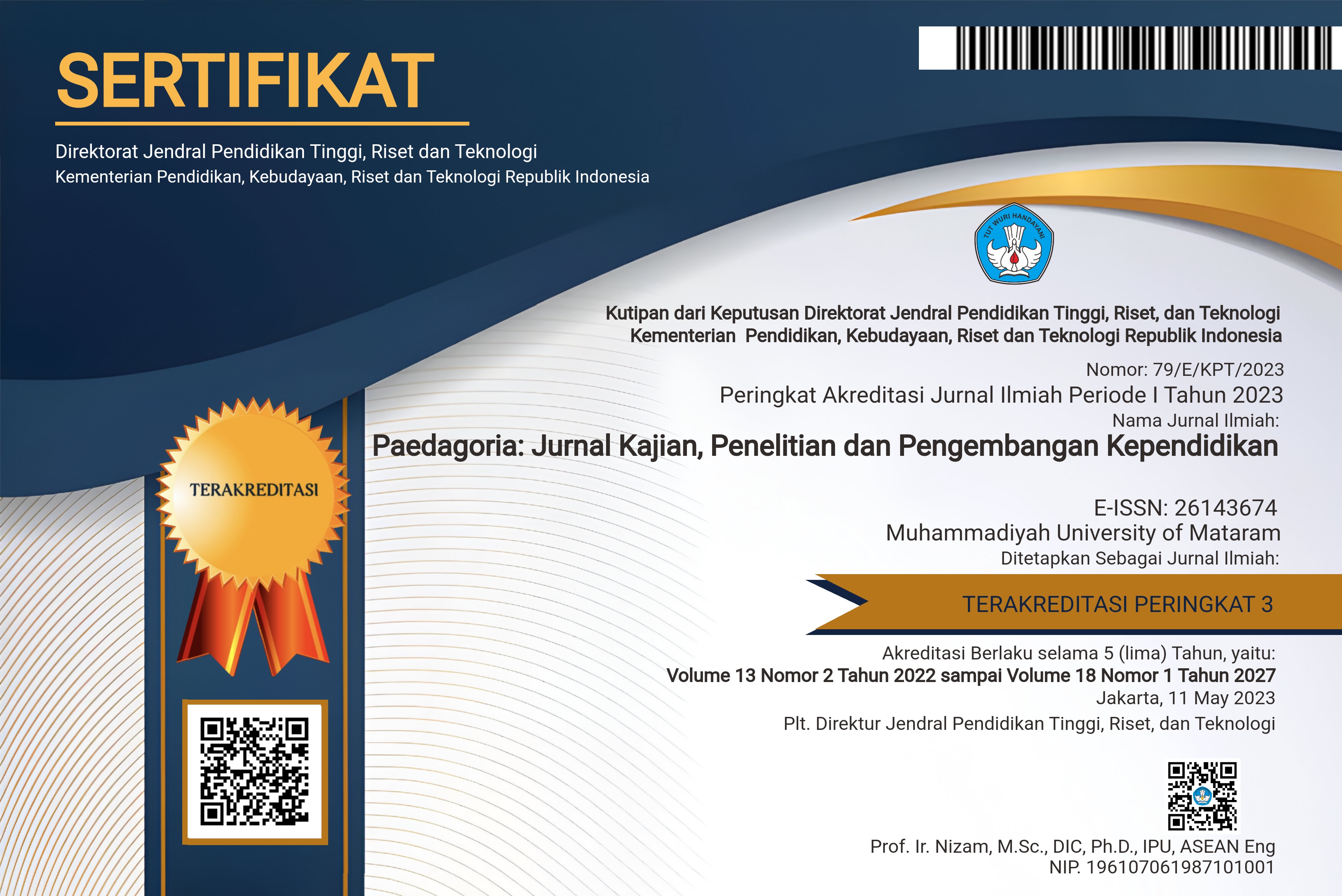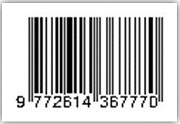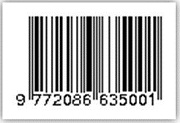IMPLEMENTING MODELED WRITING IN ESP WRITING COURSE: A CLASSROOM PRACTICE AND STANCE
Abstract
Abstrak: Penelitian ini bertujuan untuk menjelaskan tentang penggunaan model writing dalam mata kuliah English for Specific Purposes (ESP) dan bagaimana pandangan mahasiswa terhadap model writing tersebut. Penelitian ini menggunakan studi deskriptif kualitatif. Sebanyak 11 mahasiswa dari semester 3 jurusan administrasi perkantoran di salah satu universitas swasta di Depok, Jawa Barat, Indonesia, berpartisipasi dalam penelitian ini. Analisis dokumen dan wawancara langsung dilakukan untuk mengumpulkan data. Hasil analisis dokumen menunjukkan bahwa model penulisan yang ditawarkan dalam mata kuliah ini sebagian besar terdiri dari penyajian teks model, termasuk surat, bagian surat yang terperinci, kalimat yang relevan, istilah teknis, dan gaya surat. Hasil wawancara menunjukkan pandangan positif mahasiswa terhadap strategi ini, terutama mengenai materi yang tidak otentik, pemahaman, dan pengajaran deduktif dosen. Temuan penelitian menunjukkan bahwa model pembelajaran menulis diimplementasikan dengan menyajikan teks model dan pendekatan pengajaran deduktif. Penelitian ini merekomendasikan adaptasi strategi ini dalam mata kuliah menulis ESP, konsistensi dan intensitas penyajian teks model yang memadai, urgensi untuk memperbarui materi pembelajaran, dan investigasi keefektifan strategi ini dalam mata kuliah berbasis ESP di tingkat universitas.
Abstract: This study aims to shed light on utilizing modeled writing in English for Specific Purposes (ESP) courses and how the students view the modeled writing. The study employed a qualitative descriptive study. 11 students from the 3rd semester of the office administration department of one private university in Depok, West Java, Indonesia, participated in this study. Document analysis and in-person interviews were administered to collect data. The document analysis results signified that the modeled writing offered in the course mainly consisted of presenting modeled texts, including letters, detailed letter parts, relevant sentences, technical terms, and letter styles. The interview results indicated the students' positive stance of the strategy, mainly regarding non-authentic materials, comprehension, and the lecturer’s deductive teaching. The findings indicated that modeled writing is implemented by presenting model text and deductive teaching approaches. The study recommends the adaptation of this strategy in ESP writing courses, the consistency and intensity of presenting adequate model texts, the urgency to update the learning materials, and the investigation of the strategy’s effectiveness in ESP-based courses at the university level.
Keywords
Full Text:
PDFReferences
Akdemir, A. S., & Eyerci, A. (2016). Using writing templates as materials to improve writing skills in intermediate (B1) EFL classes: An experimental study. Mersin Üniversitesi Eğitim Fakültesi Dergisi, 12(2), 747–756. https://doi.org/10.17860/efd.94338
Al-Jarf, R. (2022). A multiple-associations approach to teaching technical terms in English for specific purposes courses. International Journal of English Language Studies, 4(3), 01–09. https://doi.org/10.32996/ijels.2022.4.3.1
Al Hilali, T. S., & McKinley, J. (2021). Exploring the socio-contextual nature of workplace writing: Towards preparing learners for the complexities of English L2 writing in the workplace. English for Specific Purposes, 63, 86–97. https://doi.org/https://doi.org/10.1016/j.esp.2021.03.003
Almathkuri, J. H. (2022). Challenges encountered by Saudi ESP students : A case study of Taif University. Journal of Positive School Psychology, 6(2), 300–312.
Alston, C., & Danielson, K. A. (2020). Enacting thinking: Supporting teacher candidates in modeling writing strategies. Literacy Research and Instruction, 60(5), 1–21. https://doi.org/10.1080/19388071.2020.1822475
Alston, C. L. (2020). Expanding conceptions of modeling writing to leverage student voices. Journal of Adolescent & Adult Literacy, 64(1), 89–93. https://doi.org/10.1002/jaal.1072
Antonio, J. P., & Briones, M. A. (2022). Linguistic errors and skill-competency of students in writing business letters. Journal of English Education and Linguistics, 3(1), 64–84.
Aunurrahman, A., Hamied, F. A., & Emilia, E. (2017). Modeling academic writing for university students. Ninth International Conference on Applied Linguistics (CONAPLIN 9), 82(Conaplin 9), 1–5. https://doi.org/10.2991/conaplin-16.2017.1
Badriyah, R., Hartiningsih, S., & Sabilah, F. (2023). Is demonstration effective in teaching ESP procedure text? A qualitative study: How to make a scrunchie. VELES (Voices of English Language Education Society), 7(2), 244–252. https://doi.org/10.29408/veles.v7i2.20325
Bassett, K., Olbricht, G. R., & Shannon, K. B. (2020). Student preclass preparation by both reading the textbook and watching videos online improves exam performance in a partially flipped course. CBE Life Sciences Education, 19(3), 1–9. https://doi.org/10.1187/cbe.19-05-0094
Čolakovac, J. J., & Borucinsky, M. (2020). Promoting authenticity in the ESP classroom: The impact of ICT and use of authentic materials on reading comprehension. 5th International E-Conference on Studies in Humanities and Social Sciences, 2001, 31–44. http://centerprode.com/conferences/5IeCSHSS.html
Creswell, J. W., & Creswell, J. D. (2018). Research design: Qualitative, quantitative, and mixed methods approaches (5th ed.). SAGE Publications, Inc.
Dalglish, S. L., Khalid, H., & McMahon, S. A. (2021). Document analysis in health policy research: The READ approach. Health Policy and Planning, 35(10), 1424–1431. https://doi.org/10.1093/heapol/czaa064
Dou, A. Q., Chan, S. H., & Win, M. T. (2023). Changing visions in ESP development and teaching: Past, present, and future vistas. Frontiers in Psychology, 14. https://doi.org/10.3389/fpsyg.2023.1140659
Efrianto, Boeriswati, E., & Lustyantie, N. (2022). The effectiveness of the modeling method in learning writing poetry skills. Journal of Positive School Psychology, 6(4), 2147–2155. http://journalppw.com/
Ellis, M. (2022). How to write any type of letter. July 7. https://www.grammarly.com/blog/how-to-write-a-letter/
Elo, S., Kääriäinen, M., Kanste, O., Pölkki, T., Utriainen, K., & Kyngäs, H. (2014). Qualitative content analysis. SAGE Open, 4(1), 215824401452263. https://doi.org/10.1177/2158244014522633
Graham, S. (2019). Changing how writing is taught. Review of Research in Education, 43(1), 277–303. https://doi.org/10.3102/0091732X18821125
Herrell, A. L., & Jordan, M. L. (2015). 50 strategies for teaching English language learners (5th ed.). Pearson.
Hu, N., & Chen, M. (2022). Improving ESP writing class learning outcomes among medical university undergraduates: How do emotions impact? Frontiers in Psychologysychology, 13(June 2020), 1–12. https://doi.org/10.3389/fpsyg.2022.909590
Huber, M. M., Leach-López, M. A., Lee, E., & Mafi, S. L. (2020). Improving accounting student writing skills using writing circles. Journal of Accounting Education, 53, 100694. https://doi.org/https://doi.org/10.1016/j.jaccedu.2020.100694
Hudson, A. K., Owens, J., Moore, K. A., Lambright, K., & Wijekumar, K. (2021). “What’s the main idea?”: Using text structure to build comprehension. Reading Teacher, 75(1), 113–118. https://doi.org/10.1002/trtr.2016
Hyland, K. (2019). Second language writing (2nd ed.). Cambridge University Press.
Hyland, K. (2022). English for specific purposes: What is it and where is it taking us? ESP Today, 10(2), 202–220. https://doi.org/10.18485/esptoday.2022.10.2.1
Hyland, K., & Jiang, F. (Kevin). (2021). Delivering relevance: The emergence of ESP as a discipline. English for Specific Purposes, 64(October 2021), 13–25. https://doi.org/https://doi.org/10.1016/j.esp.2021.06.002
Jitpanich, T., Leong, L. M., & Ismail, S. A. M. M. (2022). Assessing the English writing needs of undergraduate business administration students for ESP writing course development: A case study in Thailand. LEARN Journal: Language Education and Acquisition Research Network, 15(2), 104–128.
Kang, E. Y. (2020). Using model texts as a form of feedback in L2 writing. System, 89, 102196. https://doi.org/https://doi.org/10.1016/j.system.2019.102196
Kim, B.-J. (2019). A basic study on the selection of educational contents for cultivating global business communication competence. Journal of Digital Convergence, 17(2), 91–100. https://doi.org/10.14400/JDC.2019.17.2.091
Lee, S., & Schmidgall, J. (2020). The importance of English writing skills in the international workplace. In Research Memorandum No. RM-20-07.
Luan, N. M., Rajendran, M., Sumathy, M., Edison K, T. A., Sam, T. H., A, P., & Oli, L. (2024). A study on factors influencing students’ business writing skills. World Journal of English Language, 14(6), 629–640. https://doi.org/10.5430/wjel.v14n6p629
Maharani, D. P., Rukmini, D., Faridi, A., & Astuti, P. (2022). Deductive or inductive technique: An experimental study on the academic writing of the sixth semester students of Semarang State University. Proceedings of the 6th International Conference on Science, Education and Technology (ISET 2020), 574(Iset 2020), 347–352. https://doi.org/10.2991/assehr.k.211125.065
Mansour, A. B. A. (2018). The importance of exposure to enhance the students’ speaking skills performance. International Journal of Social Science and Humanities Research, 6(4), 1422–1426. http://www.researchpublish.com/
Matondang, M., & Samosir, D. S. (2021). The use of modeled writing strategy on students’ narrative text ability at grade VIII SMP Swasta PTPN IV Bah Jambi in academic year 2019/2020. Bilingual : Jurnal Pendidikan Bahasa Inggris, 3(2), 86–93.
Mohamed, O. I., & Alani, N. N. (2022). English for specific purposes: An overview: Definitions, characteristics and development. English Language Teaching, 15(12), 28–36. https://doi.org/10.5539/elt.v15n12p28
Oviedo, F. A. C., & Charpentier, K. A. (2023). English for specific purposes activities to enhance listening and oral production for accounting. Ciencia Latina Revista Científica Multidisciplinar, 7(3), 3634–3650. https://doi.org/10.37811/cl_rcm.v7i3.6431
P21. (2019). Framework for 21st century learning. Battelle for Kids.
Patarapongsanti, A., Thongsan, N. C., Sukrutrit, P., Para, C., & Saphanuchart, N. (2022). An analysis of errors in business-oriented written paragraphs of the Thai EFL undergraduates. English Language Teaching, 15(7), 136–148. https://doi.org/10.5539/elt.v15n7p136
Prošić-Santovac, D., & Popović, A. H. (2021). Students’ attitudes towards using authentic and non-authentic materials in English language teaching at university level. Belgrade English Language and Literature Studies, 13(1), 139–165. https://doi.org/10.18485/bells.2021.13.6
Rohiyatussakinah, I., & Oktaviana, F. (2018). Improving ESP student’s writing skill by using writing essay model. Journal of English Language Teaching and Literature (JELTL), 1(1), 1–7. https://doi.org/10.47080/jeltl.v1i1.120
Sabello, S. M. A., & Oxillo-Oted, J. (2023). Effectiveness of inductive and deductive methods in enhancing the paragraph writing of junior high school students. International Journal of Social Science and Education Research Studies, 03(11), 2206–2212. https://doi.org/10.55677/ijssers/v03i11y2023-05
Schmidgall, J., & Powers, D. E. (2020a). TOEIC® Writing test scores as indicators of the functional adequacy of writing in the international workplace: Evaluation by linguistic laypersons. Assessing Writing, 46(October), 100492. https://doi.org/10.1016/j.asw.2020.100492
Schmidgall, J., & Powers, D. E. (2020b). Predicting communicative effectiveness in the international workplace: Support for TOEIC® Speaking test scores from linguistic laypersons. Language Testing, 38(2), 302–325. https://doi.org/10.1177/0265532220941803
Syazali, M., Erfan, M., Niswatul Khair, B., Rahmatih, A. N., & Hasnawati, H. (2023). The effectiveness of template and example paper implementation in developing student writing skills in science courses. Jurnal Pijar Mipa, 18(3), 336–342. https://doi.org/10.29303/jpm.v18i3.4661
Thornbury, S. (2007). How to teach grammar (2nd ed.). Longman.
Tongpoon-Patanasorn, A. (2018). Developing a frequent technical words list for finance: A hybrid approach. English for Specific Purposes, 51(July), 45–54. https://doi.org/https://doi.org/10.1016/j.esp.2018.03.002
Trilling, B., & Fadel, C. (2009). 21st century skills: Learning for life in our times. Jossey-Bass.
Umirova, D. (2020). Authenticity and authentic materials: History and present. European Journal of Research and Reflection in Educational Sciences, 8(10), 129–133. http://www.idpublications.org/
van Laar, E., van Deursen, A. J. A. M., van Dijk, J. A. G. M., & de Haan, J. (2020). Determinants of 21st-century skills and 21st-century digital skills for workers: A systematic literature review. Sage Open, 10(1), 2158244019900176. https://doi.org/10.1177/2158244019900176
Villarreal, I., & Lázaro-Ibarrola, A. (2022). Models in collaborative writing among CLIL learners of English in primary school: Linguistic outcomes and motivation matters. System, 110(November), 102922. https://doi.org/10.1016/j.system.2022.102922
Wahyuni, D. S., Darmansyah, D., & Yeni, F. (2021). Writing skills deficiency in English for specific purposes (Esp): English for computer science. Journal of Applied Studies in Language, 5(1), 95–100. https://doi.org/10.31940/jasl.v5i1.2385
Wu, Z., Qie, J., & Wang, X. (2023). Using model texts as a type of feedback in EFL writing. Frontiers in Psychology, 14(June), 01–12. https://doi.org/10.3389/fpsyg.2023.1156553
Yingying, J. (2020). Research on language characteristics of business letter writing. Studies in Literature and Language, 20(3), 128–137. https://doi.org/10.3968/11717
DOI: https://doi.org/10.31764/paedagoria.v16i1.26878
Refbacks
- There are currently no refbacks.
Copyright (c) 2025 Susilawati Susilawati, Rina Riniawati, Nurhasanah Halim, Baiatun Nisa, Retno Dwigustini

This work is licensed under a Creative Commons Attribution-ShareAlike 4.0 International License.
Paedagoria : Jurnal Kajian, Penelitian dan Pengembangan Kependidikan
Fakultas Keguruan & Ilmu Pendidikan | Universitas Muhammadiyah Mataram.
_______________________________________________
 | Paedagoria : Jurnal Kajian, Penelitian dan Pengembangan Kependidikan |
______________________________________________
CURRENT INDEXING:
EDITORIAL OFFICE:


















